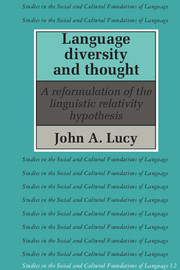Book contents
- Frontmatter
- Contents
- List of figures
- Acknowledgments
- Introduction
- 1 Development of the linguistic relativity hypothesis in America: Boas and Sapir
- 2 Development of the linguistic relativity hypothesis in America: Whorf
- 3 Approaches in anthropological linguistics: typical ethnographic case studies
- 4 Approaches in anthropological linguistics: theoretical and methodological advances
- 5 Approaches in comparative psycholinguistics: experimental studies on the lexical coding of color
- 6 Approaches in comparative psycholinguistics: experimental studies on grammatical categories
- 7 Overview and assessment of previous empirical research
- Notes
- References
- Index
Introduction
Published online by Cambridge University Press: 05 June 2012
- Frontmatter
- Contents
- List of figures
- Acknowledgments
- Introduction
- 1 Development of the linguistic relativity hypothesis in America: Boas and Sapir
- 2 Development of the linguistic relativity hypothesis in America: Whorf
- 3 Approaches in anthropological linguistics: typical ethnographic case studies
- 4 Approaches in anthropological linguistics: theoretical and methodological advances
- 5 Approaches in comparative psycholinguistics: experimental studies on the lexical coding of color
- 6 Approaches in comparative psycholinguistics: experimental studies on grammatical categories
- 7 Overview and assessment of previous empirical research
- Notes
- References
- Index
Summary
General orientation
This study examines the linguistic relativity hypothesis, that is, the proposal that diverse languages influence the thought of those who speak them. This has been an important issue in our intellectual tradition for several hundred years. How far back the concern can be traced is largely a function of how one understands the terms language and thought and how explicit an hypothesis one requires. Relatively contemporary formulations begin to appear in eighteenth-century Germany with the work of Machaelis, Hamann, and Herder (R. L. Brown, 1967; Koerner, 1977; Penn, 1972; Stam, 1980; cf. Aarsleff, 1982; Friedrich, 1986). Interest continues in the nineteenth century, again particularly in Germany, and begins to separate from speculative philosophy, especially in the work of Wm. von Humboldt. In the twentieth century the main line of empirical research moves to America with the development of Boasian anthropology. There are undoubtedly important connections between this new work in America and the earlier nineteenth-century German work of Humboldt, Müller, and Steinthal (Haugen, 1977; Hymes, 1963; Stam, 1980), but there was fresh impetus too deriving from firsthand contact with the incredible diversity of native American linguistic forms and from the emergence in contemporary anthropology of an anti-evolutionary project with an emphasis on the functionally and temporally equivalent value of these diverse languages (Stocking, 1974).
The general roots of our interest in the problem of linguistic relativity have never been extensively examined, although this is an important problem (Lucy, 1985a; cf. Friedrich, 1986).
- Type
- Chapter
- Information
- Language Diversity and ThoughtA Reformulation of the Linguistic Relativity Hypothesis, pp. 1 - 10Publisher: Cambridge University PressPrint publication year: 1992

